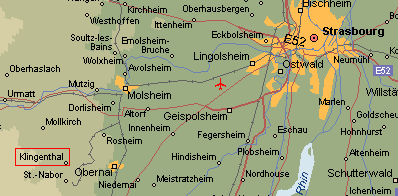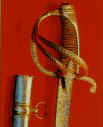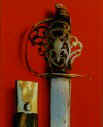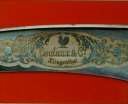 |
|
Our Alsatian land boasts of a rich and tormented history; away from all main
tourist routes, where some villages would rather keep their history discreet.
In Klingenthal, a small village near Obernai, there are no mysteries, no legends,
no medieval fortifications, no impressives towers, not even ornate half-timbered
houses and yet here lies a legacy of the past, ready to be awakened, the first
French Royal Manufacture of cutting weapons !
In 1729 Paris, Louis the XVth, King of France wants to establish his own
military cutting weapon manufacturing factory so as not to depend on foreign
suppliers and especially of those in Solingen, Westphalia, Germany. Acting upon
the proposition of Monsieur d’Angerviliers, a former Intendant of Alsace, the
creation of a manufacturing facility is entrusted to Henri Anthes, who operated
a forge and foundry in Rothau, 40 miles away from Klingenthal where ultimately
the new manufacturing site was to be located. In January 1730, Henry Anthes tests his manufacturing methods with 10 specialized workers out of Solingen. At the risk of their lives, they will pass on their know-how and the secrets of their trades. They will be the first ten workers of the new manufacturing plant. On the 15 july 1730, the king grants him his commission: "for the establishment of a Royal Manufacture of cutting weapons in Alsace, on a 30 year lease, for the service of royal troops".
The first workers of Klingenthal
The manufacturing plant is constructed on a piece of land owned by the "Great
Chapter of the Cathedral of Strasbourg". The Ehn river provides the
necessary power. Henri Anthes transforms an existing mill to make the first
forge hammer, he builds a sharpening unit, workshops and lodgings for the
workers.
As early as 1731, the manufacturing plant starts delivering weapons. The first
blades bear the signature of "Manufacture Royale d'Alsaces".
Later, the manufacturing facility takes on the name of "Klingenthal",
drawn from the blades it makes (Klingen) and its geographic location in a valley.(Thal).
The new manufacturing plant is very prosperous. New buildings are erected.
Hammers and sharpening shops stretch along the river surrounded by other
workshops for forgers, temperers, founders, grinders and assembly workers,
together with houses for workers, inspectors and the Director himself. A village
is born in the green valley that vibrates with life to the unrelenting rhythm of
the forge hammer striking the anvil.
With succeeding Directors, the workers are treated with somber days alternating
with brighter periods, but the weapons coming out of Klingenthal are always made
with equal dedication by ingenious and talented workers.
Here are made all the blades for swords and sabres of the French army: bayonets,
sabres for grenadiers, light and line cavalry, infantry swords, officers swords
and sabres and even chest-armor for the imperial guard. The forge-hammers
provide steel bars, the forgers use all their talent to stretch and shape the
red-hot metal in order to manufacture handles, hilts, mountings, leather or
metal sheaths.
Certain blades that are destined for high ranking or general officers, are
engraved and decorated, "bleuded" and gilded for the honor and pride
of those who will carry them.
Alas,prosperity is not eternal...
The successive invasions of 1814 and 1815 led the headquarters to reconsider the
location of the manufacturing facility, set so close to the border of Germany,
even though it had been quite convenient for over a century. Klingenthal closes
its works in 1836, without reprieve since a new manufacturing facility was just
opened in Chatellerault in 1818.
The manufacturing facility at Klingenthal is then taken over by the COULAUX
family. They do not forge weapons anymore but tools and specially scythes and
sickles. This time, the specialists come again from Solingen and also from
Tyrol, in Austria. Activity roars again in the valley and the forge now rings to
the rhythm of harvests. To adapt the workshops to the new lines of production,
installations and hydraulic equipment are widely transformed. Coulaux scythes
soon reach world-wide renown. Orders from the military are coming in again for
bayonet-sabres for the 1866 famous Chassepot” rifle that is produced in
Mutzig, less than 20 miles away. Hard times come again at the beginning of the 20th century ; progress and modern industry finally get the better over the simplicity of artisan custom operations. In February 1962, the "Journal Official" announces the definitive closing of the production of the Coulaux Scythes.
The forge fires are out, the hammers are silent, and Klingenthal has lost its
past glory, but the proud memory remains, that is, if one takes the time to look
and remember.
|



